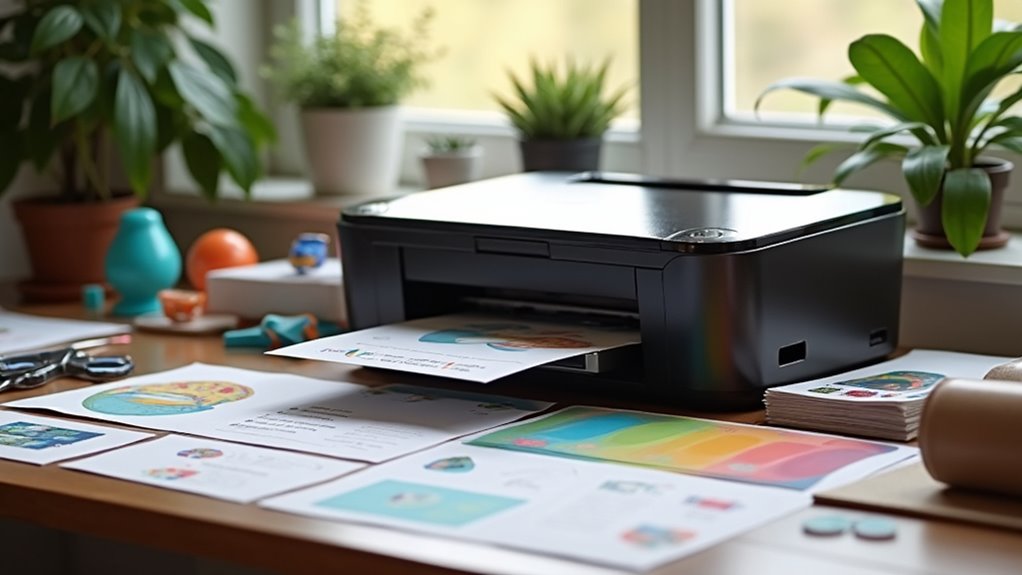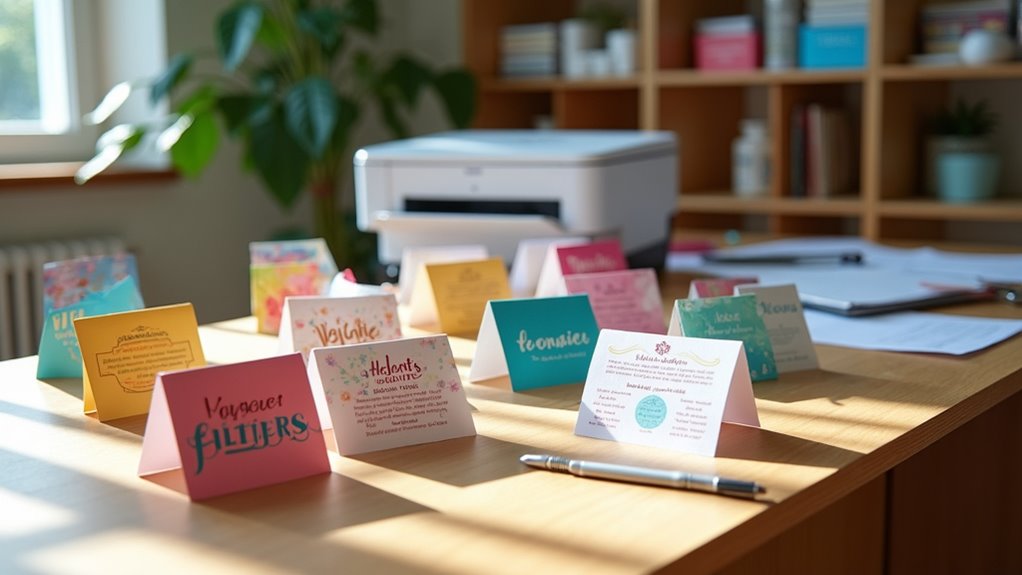How To Print Tent Cards
This post contains affiliate links. As an Amazon Associate, we earn from qualifying purchases.
To print tent cards effectively, use durable materials like 350gsm silk cardstock or 14pt cover stock and create a bold, clear design. Select digital printing for small runs or offset printing for larger quantities, then fold and secure the cards neatly with a bone folder and double-sided tape. Further explanation and detailed steps will be provided later in the article for those interested in a deeper understanding.
Essential Facts in 30 Seconds
- Use durable materials like 350gsm silk cardstock or 14pt cover stock for tent cards.
- Create designs with clear headlines and calls to action.
- Select digital printing for small orders and offset printing for large batches.
- Score and fold the cardstock at the midpoint for a professional finish.
- Ensure glue is fully dry to maintain card stability.
Selecting the Right Materials for Tent Cards

Select materials that balance strength and style for tent cards.
Use 350gsm silk cardstock for strong, durable cards. Choose 14pt cover stock for sturdy cards that print well.
Kraft paper and recycled card stocks offer eco-friendly, natural textures. Lamination adds shine or matte finish and protects cards from wear.
Larger cards need thicker materials to stay firm. Match materials to your brand for a solid, good-looking product.
Designing Your Tent Card Layout
Design your tent card to grab attention and stay easy to read. Use common sizes like 5″ x 7″ or 6″ x 4″ for a good balance. Make sure your design fits the fold and stands up well. Both sides should show important information clearly.
Pick fonts that are simple and clear. Dark text on a light background works best. Keep your message short and strong. Use a bold headline and a clear call to action. Put key details where people see them first—at eye level. Incorporating table layout can help in visual organization and clarity.
Leave space around text to avoid clutter. This helps people read your card easily. Use your brand colors and logos on both sides for quick recognition. Make the call to action stand out. Clear messages always beat strict format rules. Additionally, incorporating brand identity into your design can enhance customer recall and create a lasting impression.
Following these tips makes your tent card more effective. It will catch eyes and hold attention fast. Simple, clear, and bold works every time.
Choosing the Appropriate Printing Method

The right printing method makes tent cards look great and saves money. Each method has strong points for quality and cost. Here is a quick guide:
- Digital Printing: Works well for small orders. Colors are bright. Fast service.
- Offset Printing: Best for large orders. Prints stay the same each time. Costs less per card.
- UV Printing: Prints last long and resist scratches. Good for outdoor use.
- Dye Sublimation: Used for fabric cards, not common for paper cards.
- Screen Printing: Good for simple, bulk designs. Not good for detailed cards.
Think about how many cards you need, how strong they should be, and your budget. Pick the method that fits your needs for quality and cost.
Folding and Finishing Your Tent Cards
Select the right printing method for your tent cards first. Score the cardstock at the midpoint to make a clean fold. This fold will create an inverted V shape. Use a bone folder tool to press the fold sharply. It makes the tent card look neat and professional.
Know the difference between mountain and valley folds. These folds help the card stand correctly. Mark light pencil points to guide your folding.
Use double-sided tape or clear glue for sticking parts. Apply adhesive only after folding to avoid damage. Put glue or tape on the tabs carefully. Make sure the parts line up well.
Let the glue dry fully before moving the card. This keeps the tent card strong and stable.
Applications and Uses of Tent Cards

Tent cards work well in many places. They help share information and catch attention.
Use tent cards to promote concerts, parties, and conferences at partner venues. Show specials and new menu items right on dining tables. Mark tables with numbers for weddings and formal dinners. Boost sales by displaying popular products at checkout. Teach and engage visitors with facts at trade shows.
Simple, clear, and visible—tent cards make messages stand out.
Frequently Asked Questions
What Software Is Best for Designing Tent Cards?
Canva works great for designing tent cards. It has easy tools and many templates to pick from. You can change colors, text, and pictures quickly. This helps your tent cards look unique and catch attention. Many people use Canva because it saves time and looks professional. Try it to make your tent cards stand out at any event.
Can I Print Tent Cards at Home?
Printing tent cards at home works well with cardstock paper. Use the right printer settings for thick paper. Check your printer can handle heavy paper to avoid jams. Bright colors and clear text make cards look great. Tent cards add style and help organize events easily. Simple steps bring professional results without extra cost.
How Do I Ensure Proper Alignment When Printing?
To get your prints lined up right, use gridlines and center tools in your software. Check your printer settings too. Make sure paper feeds in the correct direction. Set the orientation to match your design. These steps help avoid crooked or cut-off prints. Proper alignment saves paper and time. Easy to do and worth it!
What Is the Average Cost for Printing Tent Cards?
Ordering 100 tent cards usually costs about $1.99 each. Printing more cards lowers the price a lot. For example, ordering many cards can bring the price down to just $0.50 each. Buying in bulk saves money. This makes tent cards affordable for events and businesses.
How Can I Store Tent Cards to Prevent Damage?
Store tent cards in clear protective sleeves to keep them clean. Use sturdy cardboard boxes to hold the sleeved cards. This stops dust from settling and prevents the cards from bending. Keep the boxes in a dry, cool place to avoid moisture damage. Organizing cards by size or event makes finding them quick and easy later. This simple care saves money by keeping cards nice for many uses.
Conclusion
Visualize bright colors and clear designs catching eyes. Use strong materials and good printing methods to make great tent cards. These cards work well for events or daily use. Small details matter. Spend time on design and finishing to make your cards stand out. Quality tent cards help share your message clearly and attract attention.
